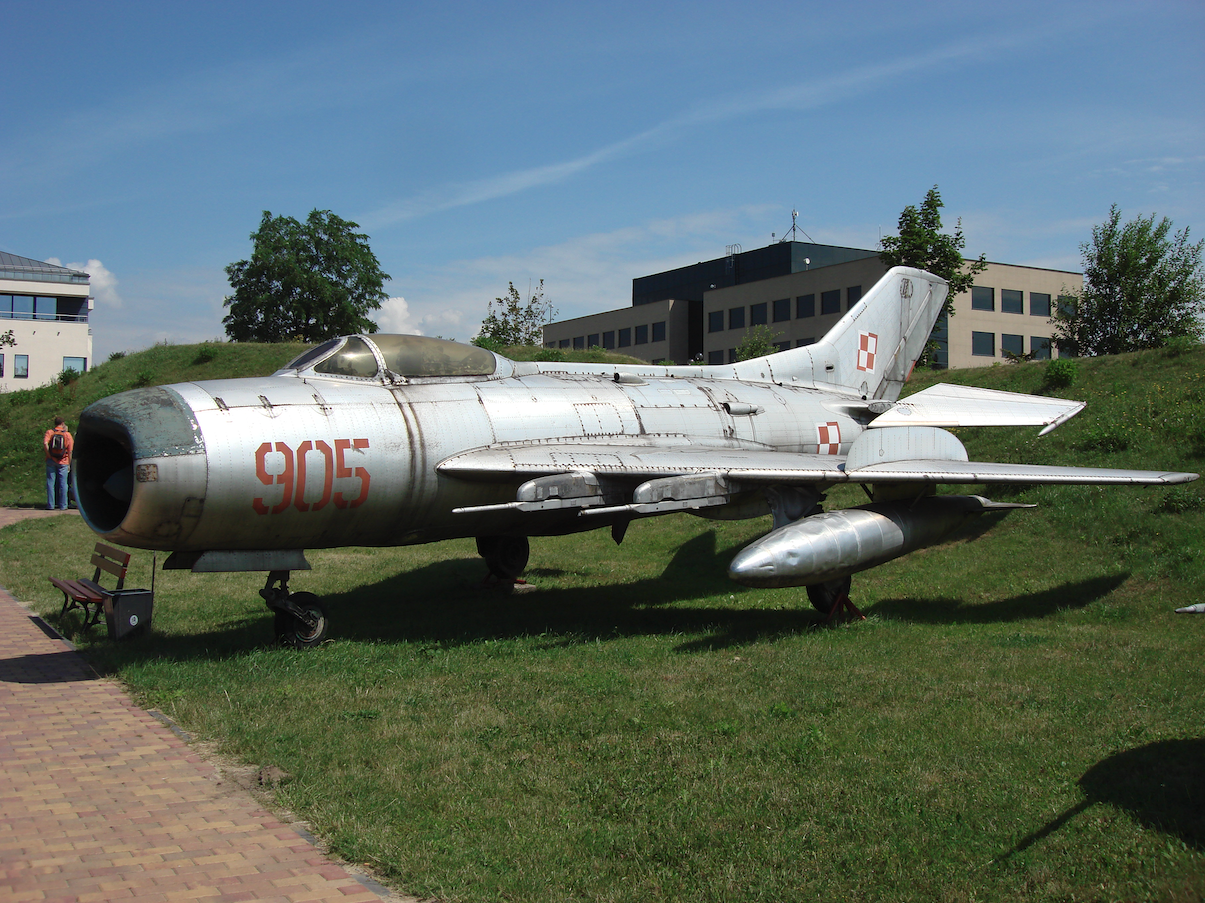Kraków 2007-07-07
153 Rozdział 1957-12-03.
OKB Mikojan i Guriewicz MiG-19 P, PM.
Historia samolotu MiG-19.
W Wojsku Polskim maszyna Mikojan i Guriewicz MiG-19 była pierwszym naddźwiękowym samolotem myśliwski, a jednocześnie pierwszym uzbrojonym w kierowane pociski rakietowe klasy powietrze – powietrze.
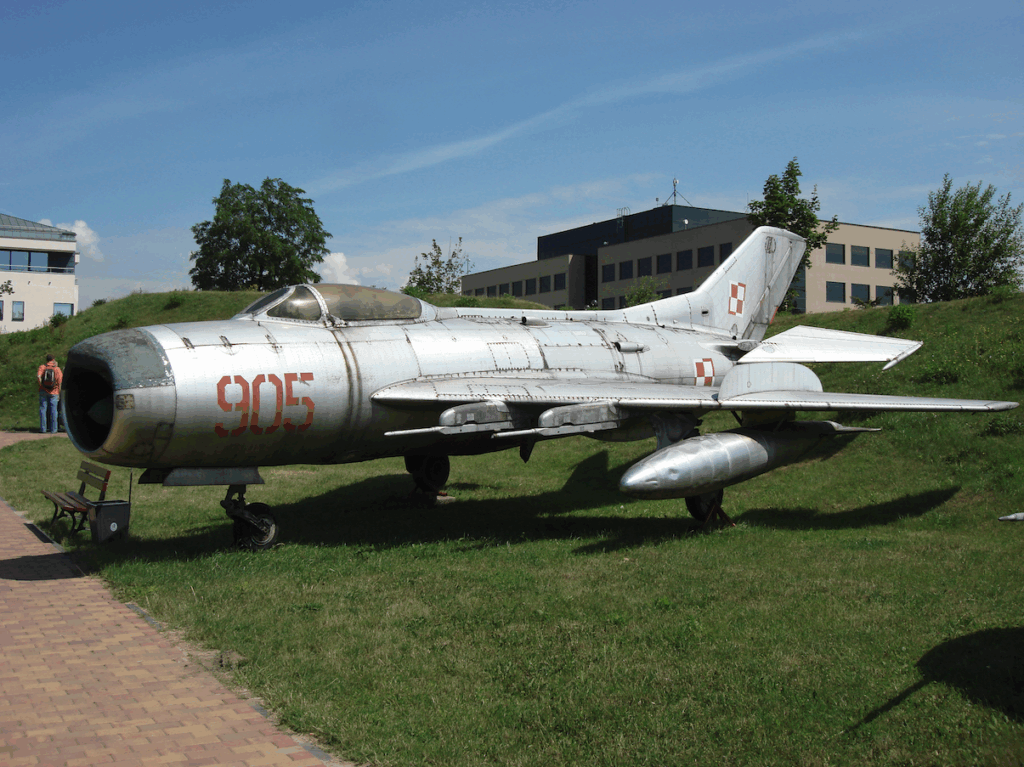
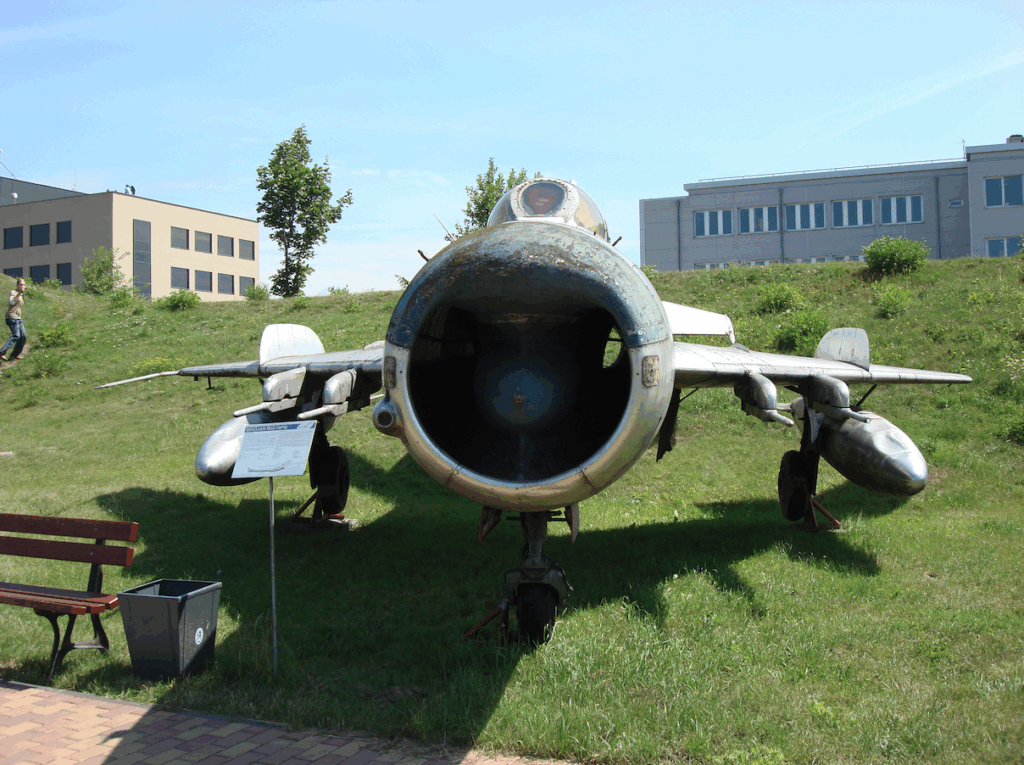
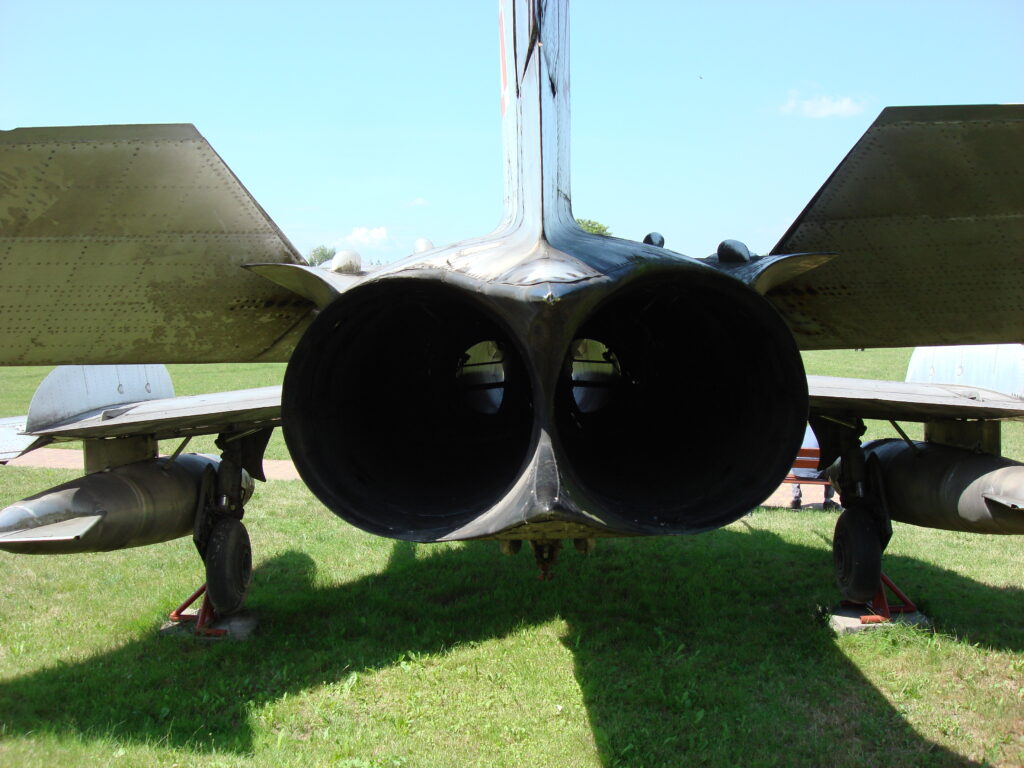
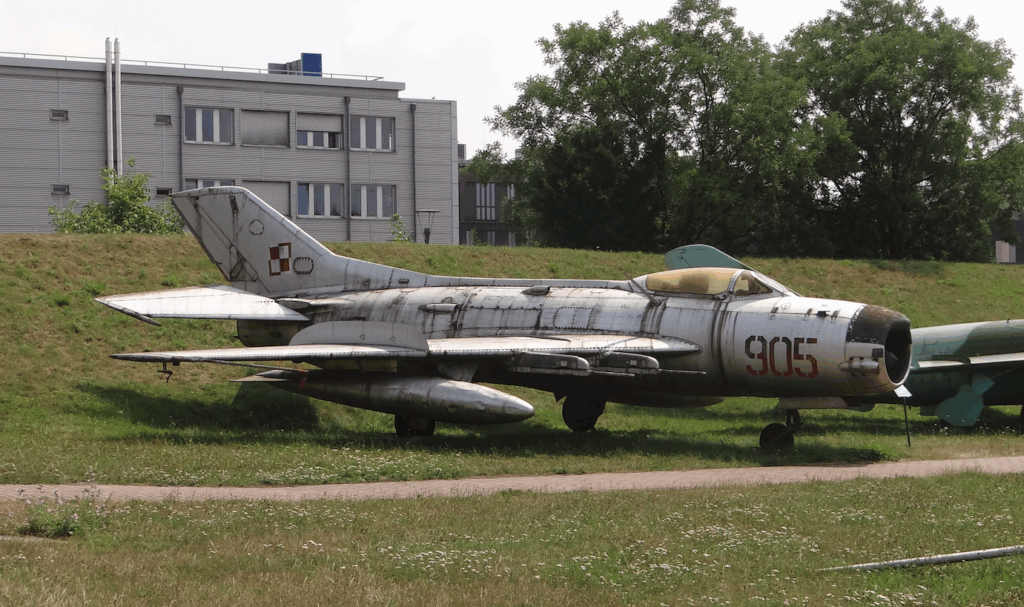
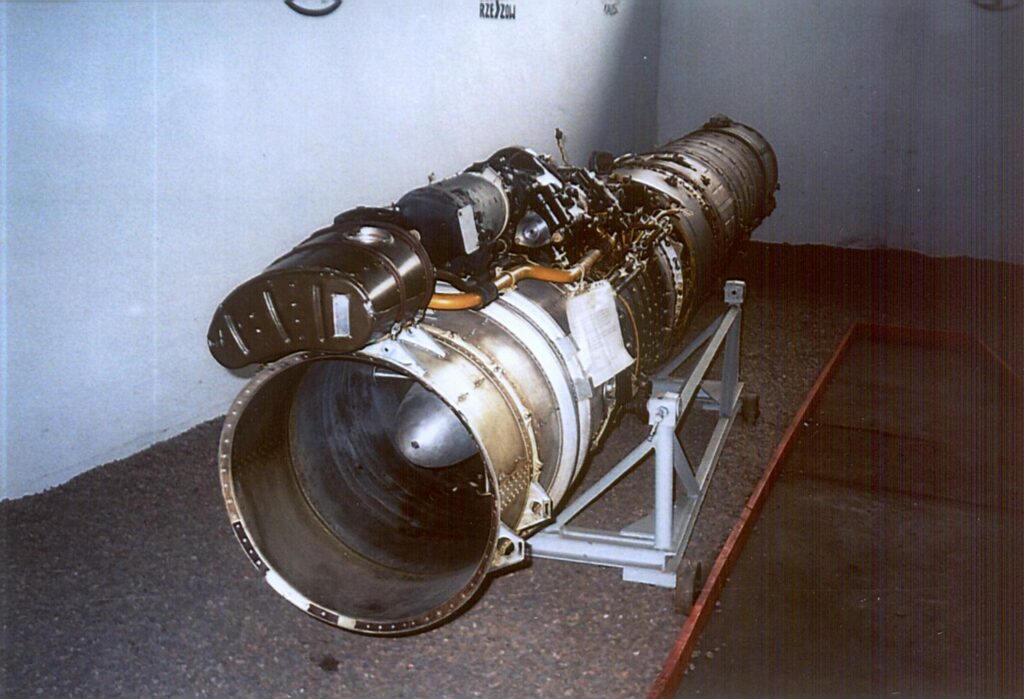
Mikojan i Guriewicz MiG-19. 1952 rok.
MiG-19 nie był logiczną kontynuacją samolotów myśliwskich MiG-15, MiG-17. Różnił się od nich niemal wszystkim. Cechy wspólne to tylko czołowy chwyt powietrza i skośne skrzydła. Co najważniejsze, z powodu dwusilnikowego zespołu napędowego i wielkości, należał do ciężkich myśliwców, a poprzednicy do średnich. MiG-19 został wprowadzony na uzbrojenie na wyraźne polecenie Moskwy. Stało się tak dlatego, że w USAF zaczęto wprowadzać na uzbrojenie myśliwce F-100 C. Samolot F-100 C miał prędkość naddźwiękową, a co ważne zdolny był do przenoszenia broni jądrowej. Decyzja Moskwy miała przywrócić równowagę w posiadanej technice.
Biuro OKB Mikojana i Guriewicza dysponowało już kilkoma konstrukcjami zdolnymi do osiągania prędkości naddźwiękowej. Lecz były kłopoty z utrzymaniem tej prędkości ciągle. Należy tu wymienić konstrukcje I-340 ( SM-1 ) i I-350 ( M ). Na przeszkodzie stał brak odpowiedniego silnika turboodrzutowego. W tym miejscu, należy przypomnieć bardzo obiecujący silnik TR-1, z którym wiązano wielkie nadzieje. Jednak silnik okazał się całkowicie nieudany, a to pociągnęło za sobą upadek kilku konstrukcji o przewidywanej prędkości naddźwiękowej, na przykład Suchoj Su-17 (nie mylić z późniejszym samolotem Suchoj Su-17).
W dniu 27 maja 1952 roku, został oblatany samolot I-360 ( SM-2 ). Został on wyposażony w dwa silniki A. Mikulina AM-5 o ciągu 2 x 1 962 kG. Choć silniki były wyposażone w sprężarki osiowe i były obiecujące, to ich zbyt mały ciąg nie zapewniał lotów z prędkościami naddźwiękowymi. Dodatkowo zdarzały się częste awarie. Urywały się na przykład łopatki turbiny.
Na szczęście opracowano poprawiony silnik, który oznaczono AM-9, o ciągu 2 x 2 550 kG. Silniki te umożliwiły loty z prędkością naddźwiękową. Samolot I-360 ( SM-2 ) wykonał 132 loty. We wszystkich lotach maszynę pilotował G. Siedow.
I właśnie w tym momencie Kreml podjął decyzję o wprowadzeniu tej konstrukcji na uzbrojenie. Zdawano sobie sprawę z mankamentów konstrukcji, ale wyjścia nie było. Inne konstrukcje w CCCP były jeszcze bardziej opóźnione.
Bezpośrednim wzorem samolotu seryjnego MiG-19 stał się SM-9/1, który wykonał pierwszy lot w dniu 5 stycznia 1954 roku. Konstrukcja miała wiele niedostatków. Przede wszystkim w locie naddźwiękowym usterzenie okazał się mało skuteczne. Podjęto prace nad wprowadzeniem usterzenia typu płytowego. Prace nad nim trwały przez cały 1954 rok. Innym mankamentem był brak dostatecznej stateczności. Problem ten został rozwiązany dopiero przy wersji MiG-19 S.
Loty doświadczalne na SM-9/1 wykonywali piloci K. Kokinaki, Georgii Masłow oraz bratanek konstruktora samolotu S. Mikojan. Jednocześnie nie ustawały prace nad udoskonalaniem silnika. Pracami kierował S. Tumański, następca A. Mikulina. Silnik otrzymał oznaczenie produkcyjne RD-9 i dysponował już ciągiem 2 x 3 300 kG z dopalaniem.
Produkcja pierwszej wersji MiG-19 była bardzo krótka. Zbudowano niewielką ilość egzemplarzy, raczej z powodów propagandowych, gdyż samolot nadal miał wiele niedostatków. W lipcu 1955 roku, samolot MiG-19 pokazano na paradzie lotniczej w Tuszyno.
Niedługo później rozpoczęła się produkcja seryjna samolotu MiG-19 S ( S – stabilizator ), pochodzącego od prototypu SM-9/3. Ta konstrukcja okazała się już udana. Bezpośrednio od tej wersji pochodzą samoloty o różnym przeznaczeniu. Powstał w 1956 roku, myśliwiec wysokościowy MiG-19 SW ( W – wysotnyj ). Samolot rozpoznawczy MiG-19 R ( R – razwiedczik ) i krótka seria samolotów MiG-19 SF osiągających prędkość 1 560 km/h.
Drugą linię rozwojową stanowiły samoloty budowane na bazie prototypu SM-7 wyposażonego w SR (radar) RP-5, a ściślej celownik radiolokacyjny. Dzięki temu powstały nowe myśliwce przechwytujące. Prototyp SM-7/2 przerodził się w myśliwiec MiG-19 P ( P – pieriechwatczik ). Następnie zbudowano MiG-19 PF. Powstała także wersja MiG-19 PG ze SR (radarem) Gorizont-1, która służyła do naprowadzania samolotu na cel według wskazań naziemnego punktu dowodzenia. Zbudowano także krótką serię samolotów MiG-19 PU ( U – uskoritiel ) z dodatkowymi przyspieszaczami rakietowymi.
Prototyp SM-7/2 M wyposażono w nową SR (radar) oznaczoną RP-2 U ( Izumrud-2 ) i uzbrojony w 4 k.p.r. RS-2 U ( K-5 ). Samolot produkowano seryjne pod oznaczeniem MiG-19 PM ( M – moddyfikowannyj ). Ten sam samolot z urządzeniem telemetrycznym „Łazur” oznaczono MiG-19 PMŁ.
OKB Mikojana i Guriewicza nadal rozwijało także linię samolotów eksperymentalnych SM, których celem była budowa nowego myśliwca. Wymieńmy; SM-10 – tankowanie w powietrzu, SM-12 – nowe chwyty powietrza, SM-30 – zerowy start, SM-50 – dodatkowy silnik rakietowy.
MiG-19 trafił na uzbrojenie państw UW ( Układu Warszawskiego ); CCCP, Bułgarii, Czechosłowacji, NRD, Polski, Rumunii i Węgier oraz do Chin, Egiptu, Indonezji, Iraku, Pakistanu, Syrii i na Kubę. Jego produkcję podjęto w Czechosłowacji, ale tylko wersji MiG-19 S, czyli bez SR (radaru), pod oznaczeniem S-105. Produkcję podjęły także Chiny. Produkowano tam nie tylko samoloty z licencji, ale także rozwinięto własne wersje.
MiG-19 dla Polski.
W połowie 50-lat było już pewne, że epoka myśliwców naddźwiękowych zbliża się nieodwracalnie. Wojsko Polskie miało już bardzo dobre myśliwce Lim-5 wyposażonym w SR (radar) lecz nie były one w stanie dostatecznie szybko przepłoszyć samoloty rozpoznawczo-zwiadowcze krajów NATO w postaci maszyn U-2, Canberra PR i Atlantic. Samoloty te systematycznie naruszały terytorium Polski, głównie morskie. Dlatego myśliwiec naddźwiękowy, zdolny do działań w dzień i w nocy byłby dobrym rozwiązaniem.
Pierwsze próby zakupu samolotów naddźwiękowych przez władze polskie czynione były w drugiej połowie 50-lat. W lipcu 1956 roku i w styczniu 1957 roku, podpisano wstępne dokumenty przewidujące produkcję licencyjną samolotu myśliwskiego MiG-19, pod oznaczeniem Lim-7. Jednak kryzys społeczno-polityczny w maju 1957 roku, w Polsce spowodował wzrost nieufności przywódców w Moskwie. Już podczas prowadzenia wstępnych rozmów na Kremlu w dniach 24-25 maj 1957 roku. Chruszczow oświadczył, że CCCP w żadnym wypadku nie przekaże Polsce praw licencji na produkcję MiG-19. Uzyskaliśmy tylko zgodę na kupienie 33 maszyn typu MiG-19 w dwóch wersjach; MiG-19 P z celownikiem radiolokacyjnym i armatkami oraz MiG-19 PM z celownikiem radiolokacyjnym i pociskami kierowanymi RS-2 US. Z samolotów tych planowano utworzyć trzy eskadry pościgowe na kierunku północnym – w Słupsku, na kierunku zachodnim – Poznań Krzesiny, na kierunku południowym – Mierzęcice.
Co do dokładnej liczby maszyn to istnieją rozbieżności. Najbardziej prawdopodobna jest liczba 33 sztuk. Liczba 36 pojawia się z powodu tak zwanego obłożenia etatowego. W tym czasie pułk myśliwski miał mieć na stanie 36 samolotów bojowych, nie licząc samolotów szkolno-bojowych.
Samoloty w wersji MiG-19 P zostały sprowadzone w dwóch dostawach. W dniu 3 grudnia 1957 roku, przyleciało do Polski 9 fabrycznie nowych maszyn. W dniu 17 maja 1958 roku, przyleciało kolejne 10 egzemplarzy. Samolotów w wersji MiG-19 PM było 14 egzemplarzy i dostarczone zostały na przełomie 1958/1959 roku.
Jako pierwszych do przeszkolenia na nowy samolot wytypowano pilotów; kpt. Czesław Kantyka i kpt. Zdzisław Mickiewicz. Pilotów tych przeszkolono w CCCP. Byli to prawdopodobnie jedyni nasi piloci wyszkoleni w CCCP. Pozostali zostali wyszkoleni w Polsce. Już wcześniej widziano konieczność przeprowadzania szkoleń na terenie Polski. Na miejsce szkolenia wybrano Modlin. Nowe samoloty początkowo znalazły się na lotnisku w Modlinie, gdzie sformowano Wyższą Szkołę Pilotów. Przeszkalanie pilotów w WSP na nowy sprzęt rozpoczęto w maju 1958 roku. Pierwsze systemowe szkolenie grupy 9 pilotów prowadził kpt. Czesław Kantyka.
Z początkiem 1959 roku, samoloty zgodnie z planem, utworzyły eskadry przechwytujące ( pościgowe ) i osiągnęły gotowość operacyjną. Z dostarczonych samolotów utworzono eskadry przechwytujące, po jednej w 28. PLM na lotnisku Słupsk-Rędzikowo, 62. PLM bazującym na lotnisku Poznań-Krzesiny i 39. PLM na lotnisku Mierzęcice.
Wersje używane w Polsce.
MiG-19 P ( inaczej samolot 62 ) – maszynę wyposażono w stację radiolokacyjną (radar) RP-5, dwuantenową. Nad wlotem antena poszukiwania, w przegrodzie antena śledzenia. Kadłub w stosunku do wersji MiG-19 S wydłużono o 0,9 m. Stacja radiolokacyjna wymusiła zmianę uzbrojenia. Dla zachowania masy samolotu usunięto działko z kadłuba samolotu. Pozostawiono dwa działka NR-30 kalibru 30 mm. Dodatkowo podwieszono 2 zasobniki z niekierowanym pociskami rakietowymi.
MiG-19 PM ( modyficyrowannyj. Inaczej samolot 65 ) – jest to samolot uzbrojony wyłącznie w 4 pociski rakietowe K-5 ( RS-2US ). Stację radiolokacyjną RP-5 zastąpiono RP-2U ( Izmrud-2 ), przystosowaną do strzelania tymi pociskami.
W literaturze można spotkać informacje, ze oprócz maszyn wyposażonych w SR (radar) do Polski trafiły także MiG-19 S. Służyły głównie do szkolenia pilotów w lotach na tym typie myśliwca. Jednak nie można znaleźć żadnego zdjęcia tej wersji w barwach Polskich. Były tylko rysunki. Również żaden z pilotów nie potwierdza tych informacji. Wobec tego, informacja o posiadaniu przez Polskę wersji MiG-19 S jest mało prawdopodobna, ale nie niemożliwa. Przemawiają za tym dwa fakty. Po pierwsze podczas pierwszych pertraktacji ze stroną rosyjską mogliśmy mieć zaproponowane właśnie samoloty MiG-19 S, co jest bardzo prawdopodobne, choć ta wersja nas nie satysfakcjonowała. Po drugie, MiG-19 S pod oznaczeniem S-105 był produkowany u naszych sąsiadów, czyli w Czechosłowacji. Nie jest wiec nierealne, że kilka sztuk w drugiej połowie 60-lat mogła trafić do Polski.
Kpt. pil. Czesław Kantyka jako pierwszy polski pilot przekroczył barierę dźwięku na myśliwcu MiG-19 P podczas pokazu dla dowództwa MON (ministerstwo obrony narodowej) latem 1958 roku.
Por. pil. Roman Operacz jako pierwszy polski pilot przekroczył barierę dźwięku na myśliwcu MiG-19 P podczas publicznego pokazu w trakcie defilady w dniu 22 lipca 1959 roku.
W 1959 roku, pilot Roman Operacz przeżył chwile emocji i grozy. Po wykonaniu czynności okresowych, samolot MiG-19 P wystartował w powietrze. W czasie wykonywania ewolucji na wysokości 3 100 m i przy prędkości około 1 000 km/h, urwała się taśma amunicyjna z pociskami i przesunęła na koniec skrzydła. Gdy nie korzystano z działek nie wprowadzano taśmy z amunicją do komory, lecz tylko mocowano do zaczepów, z których się urwała. Na końcu płata taśma przecięła przekaźnik ciśnienia i przekaźnik zmieniający sterowanie samolotu w zależności od prędkości. Ster wysokości automatycznie przestawił się z dużej prędkości na małą, powodując nadsterowność. Mały ruch drążka powodował, albo niemal pionowe wznoszenie, albo nurkowanie. Roman Operacz co chwilę tracił przytomność. Przeciążenia były tak wielkie, że zerwały się pasy bezpieczeństwa i uderzył głową o osłonę kabiny. Rzucany był po całej kabinie. Po kolejnym odzyskaniu przytomności zauważył, że leci poniżej wierzchołków drzew. Wreszcie udało mu się zmniejszyć prędkość. Siedział w kabinie skurczony. Drążek trzymał u jego podstawy, a rękojeść była na wysokości twarzy. Wylądował szczęśliwie. Był potłuczony, poraniony z oczami przekrwionymi, ale żył. W szpitalu powrócił do zdrowia. Badania wykazały, że samolot był poddany przeciążeniom od +10g do -5g. Samolot miał zdeformowane skrzydła i kadłub, ale się nie rozpadł.
62 Pułk Lotnictwa Myśliwskiego w Krzesinach.
W okresie od maja do września 1958 roku, w Wyższej Szkole Pilotów w Modlinie na kursie przeszkolenia pilotów na myśliwce MiG-19 uczestniczyli piloci 62. PLM kapitanowie: Skrzydłowski i Góra oraz porucznicy: Makarewicz, Oczepko i Sobczyk (wszyscy z pierwszej eskadry). Obsługi techniczne, dotąd wchodzące w skład eskadr lotniczych, zostały z nich wyłączone.
W 62. PLM sformowano dywizjon techniczny ( DT ) składający się z trzech eskadr technicznych, powstała też sekcja elaboracji pocisków rakietowych ( SER ). Dowódcy dywizjonu technicznego podporządkowana została także sekcja inżynieryjna pułku z podległym mu działem obsługi technicznej, powstałym jeszcze w 1957 roku. Dowództwo DT objął starszy inżynier pułku kpt. inż. Mieczysław Niedzielski.
Samoloty MiG-19 P, PM były na wyposażeniu 1. Eskadry 62. PLM do 1962 roku. Ponieważ pułk wytypowano do przyjęcia nowszych samolotów MiG-21 F-13, posiadane MiG-19 P, PM przekazano do 28. PLM i 39. PLM.
39 Pułk Lotnictwa Myśliwskiego w Mierzęcicach.
Samoloty MiG-19 P były na wyposażeniu pierwszej eskadry pułku od 1958 roku. Ilość samolotów MiG-19 P, PM w pułku ulegała zmianie. Najwięcej maszyn (max 16 szt.) było na stanie pułku po przekazaniu części samolotów z pierwszej eskadry 62. PLM.
Wiosną 1962 roku, kilkuosobowa grupa pilotów wyjechała do CCCP na szkolenie w przechwytywaniu z użyciem kierowanych pocisków rakietowych RS-2 U, które były na wyposażeniu MiG-19 PM. Cała grupa składała się z pilotów z dowództwa WOPK, 28. PLM i 39. PLM, a znaleźli się w niej: mjr pil. Czesław Kantyka – dowódca grupy, kpt. pil. Henryk Dańko, por. pil. Mieczysław Furmanek, kpt. pil. Bogusław Jaromin, por. pil. Wojciech Matonóg, kpt. pil. Zdzisław Skrzydłowski, por. pil. Władysław Waltoś oraz oficer służby uzbrojenia z WOPK.
W dniu 1 lipca 1965 roku, na stanie 39. PLM było: 5 MiG-19 PM, 9 MiG-19 P, 6 Lim-5, 13 Lim-2, 8 MiG-15 UTI, 2 TS-8 Bies i 1 An-2.
W dniu 2 sierpnia 1966 roku, w 39. PLM miała miejsce katastrofa lotnicza. Pułk był przebazowany na lotnisko zapasowe w Kamieniu Śląskim. Piloci przygotowywali się do nocnego wylotu. Jako pierwszy wykołował na start kpt. pil. Eugeniusz Nasiorowski, na samolocie MiG-19 P nb 727. Podczas startu (rozbiegu), po 100-150 m, w samolocie nastąpiła asymetria ciągu. Prawy silnik pracował na maksymalnym ciągu –„forsaż”, a lewy wszedł tylko na „maksymał” lub „nominał” ( komisji powypadkowej nie udało się tego ustalić ). Samolot zboczył z pasa i sunął po trawiastej część lotniska wprost na stojankę wypełnioną samolotami. Pilot widząc zaistniałą sytuację, bojąc się zderzenia z samolotami poderwał maszynę. Zbyt mała prędkość spowodowała, że samolot przepadł z wysokości 5-10 m na skrzydło. W momencie upadku rozlało się paliwo i nastąpił wybuch. Całą tą tragiczną sytuację obserwowali inni piloci eskadry siedzący w swoich przygotowanych do startu samolotach. Natychmiast do walki z pożarem ruszyli strażacy, starając się ugasić płonący samolot, a także nie dopuścić ognia do samolotów na stojance. Niestety kpt. pil. Nasiorowski zginął w płonącej maszynie.
W trakcie służby pułk przekazał kilka samolotów MiG-19 P, PM do 28. PLM. Wycofywanie myśliwców MiG-19 z 39. PLM rozpoczęto w 1965 roku. Ostatnie loty na samolotach MiG-19 przeprowadzono w maju 1967 roku. Także w maju 1967 roku, przekazano kilka ostatnich samolotów do 28. PLM.
28 Pułk Lotnictwa Myśliwskiego w Słupsku – Redzikowo.
W 1958 roku, w 28. PLM rozpoczęto przygotowania do wprowadzenia samolotów MiG-19. Wybrano grupę pilotów i techników, którą przeszkolono w CCCP, w Nowosiejce koło Krasnodaru.
Do 28. PLM pierwsze samoloty MiG-19 P przyleciały z Modlina na początku grudnia 1958 roku. W lipcu 1959 roku, także z Modlina dostarczono 5 samolotów MiG-19 PM. W nowe samoloty przezbrojono 1 Eskadrę. Dwie pozostałe eskadry latały nadal na samolotach Lim-2 i Lim-5.
W dniu 1 stycznia 1962 roku, na stanie 28. PLM było: 5 MiG-19 PM, 7 MiG-19 P, 10 Lim-5, 7 Lim-2, 3 SBLim-1, 4 MiG-15 UTI i 4 TS-8 Bies.
W dniu 15 września 1962 roku, pułk stracił pierwszy samolot MiG-19 PM. Niestety w katastrofie zginął także pilot por. Jan Drewicz.
W paździerinku 1964 roku, 28. PLM miał na stanie: 10 MiG-19 P, 5 MiG-19 PM, 8 Lim-5, 11 Lim-2, 3 SB Lim-1, 4 MiG-15 UTI i 4 TS-8 Bies.
W listopadzie 1965 roku, z 39. PLM w Mierzęcicach przejęto kolejnych pięć MiG-19 PM. W ciągu 1966 roku, z tego pułku przejęto też kilka MiG-19 P.
Niestety, w połowie roku 1966 roku, w awariach utracono dwa samoloty MiG-19 PM. Pierwszy samolot rozbił się w dniu 20 czerwca 1966 roku, obok miejscowości Lulemino ( pilot mjr Raszewski uratował się ). Drugi samolot utracono równo miesiąc później, w dniu 20 lipca 1966 roku,. w dość niezwykłych okolicznościach. Przeszkalający się na nowy samolot ppor. pil. Zbigniew Kopacz przez pomyłkę, jeszcze na płycie postojowej uruchomił dźwignię chowania podwozia. Podwozie obciążone samolotem nie schowało się od razu lecz dopiero podczas rozbiegu. Samolot zaczął szorować dziobem o pas w efekcie czego zapalił się. Pilot zdołał opuścić kabinę lecz samolot spłonął MiG-19 PM nb 910.
W dniu 16 czerwca 1967 roku, w lądującym bombowcu Ił-28 z 19. Eskadry Holowniczej nastąpiła awaria wciągarki co spowodowało, że holowany na zbyt długiej linie „Gacek” zboczył z osi pasa w prawo i doszczętnie rozbił przednią część stojącego w trawie MiG-19 P nb 1012.
W 1970 roku, miała miejsce kolejna katastrofa, por. Władysław Raczkiewicz pilotując MiG-19 P zginął – nie zdążył wyprowadzić samolotu z lotu nurkowego podczas ataku na cel naziemny.
W 1970 roku, 28. PLM gościł u siebie eskadrę węgierskich MiG-19 S ( Węgrzy strzelali do celów nawodnych ), natomiast w lipcu 1972 roku, eskadra słupskich MiG-19 przebywała na lotnisku Rybnitz-Damgarten w NRD, gdzie stacjonowały sowiecki 773. PLM, który był wyposażony w samoloty MiG-21 PFM.
W dniu 28 marca 1973 roku, pełniący dyżur w parze dyżurnej kpt. pil. Jan Budek wystartował na MiG-19 P w celu przechwycenia niezidentyfikowanego samolotu, który znalazł się w polskiej przestrzeni powietrznej. Po wykonaiu zadania nie wrócił na macierzyste lotnisko. Najprawdopodobniej samolot wpadł do Bałtyku. Okoliczności wypadku nie wyjaśniono.
W dniu 4 grudnia 1974 roku, odbyły się ostatnie, nocne loty samolotów MiG-19. Rozstanie się z nimi nie obyło się bez problemów, w lądującym samolocie majora pilota Bonifacego Treli nie wyszło przednie podwozie.
W maju 1975 roku, z wycofanych samolotów MiG-19 P, PM wymontowano silniki, które zostały sprzedane do CCCP z przeznaczeniem na napęd latających celów Ła-17. Natomiast w czerwcu 1975 roku, rozmontowane kadłuby kilku samolotów transportem kołowym zostały przewiezione na poligon w Nadarzycach gdzie po ponownym złożeniu służyły jako cele. Cztery samoloty zostały zachowane, jeden pozostał w 28. Pułku MiG-19 PM nb 908, a dwa trafiły do muzeów w Kołobrzegu MiG-19 P nb 728 i Krakowie MiG-19 PM nb 905. Czwarty samolot został ustawiony na cokole koło dworca PKP w Świdwinie, lecz po pewnym czasie, podczas bardzo silnej wichury, spadł i został złomowany.
Samoloty MiG-19 kilkakrotnie demonstrowano na pokazach lotniczych, był to zazwyczaj przelot grupy samolotów oraz pilotaż indywidualny połączony z przekroczeniem, na dużej wysokości, prędkości dźwięku.
Próba oceny samolotu MiG-19.
MiG-19 był pierwszym samolotem naddźwiękowym w Lotnictwie Polskim i mimo, że występował w niewielkiej liczbie, pozwolił wielu pilotom na przyswojenie techniki pilotażu przy prędkościach naddźwiękowych. MiG-19 w chwili wprowadzenia go na uzbrojenie był najcięższym samolotem myśliwskim w Wojsku Polskim. W ogóle należy do grupy ciężkich myśliwców. Był pierwszym z napędem dwusilnikowym. Dysponował największą mocą ciągu, pokonując tym parametrem nawet samolot bombowy Ił-28.
W wielu publikacjach utarł się stereotyp, że MiG-19 był użytkowany w Polsce przez krótki okres. Przeczą temu fakty. Samolot wprowadzono do służby w 1957 roku, a ostatnie loty wykonano w 1975 roku, czyli 18 lat służby nie można uznać za krótki okres. Faktem jest, że dojść szybko pojawił się następca w postaci myśliwca MiG-21. Lecz pierwsze MiG-21 były w wersji MiG-21 F-13, czyli nie posiadającej celownika radiolokacyjnego (SR, radaru), co ograniczało możliwość jego użycia w nocy i przy złej pogodzie. Dlatego MiG-19 P, PM górował nad nim. Dopiero pojawienie się wersji MiG-21 PF zmieniło sytuację.
Podczas służby w katastrofach zginęło czterech polskich pilotów. W dwóch przypadkach był błąd człowieka, w jednym awaria silnika, a jeden przypadek nieznany do dnia dzisiejszego. W trzech innych wypadkach lotnicy przeżyli. W dwóch z nich życie pilota uratował fotel wyrzucany, a w trzecim pilot wylądował.
Opracował Karol Placha Hetman

